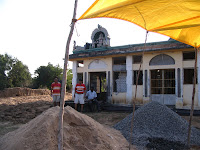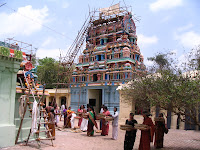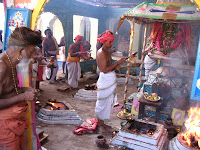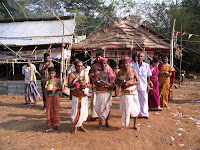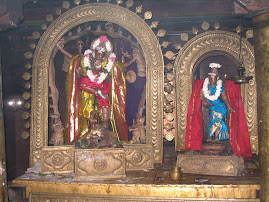 On seeing the decline in dharma and the exodus of people from villages,Kanchi Kamakoti Sankaracharya had initiated the appointment of Dharmathikari in each village to liase with locals and help the needy.It worked well for some decades. As the Govt was not prepared to take action against the erring farmers who failed to honour the contract with their landlords/temples,the landlords finally sold their lands and migrated to towns & urban areas.This was the first blow to our culture as there was no income for temples from lands.The interest shown by the remaining people was very poor.The archakas of these temples still continue to do poojas once in a day although they do not get any income out of it.Now the question is who will take care of the village temples and the archakas associated with them.
On seeing the decline in dharma and the exodus of people from villages,Kanchi Kamakoti Sankaracharya had initiated the appointment of Dharmathikari in each village to liase with locals and help the needy.It worked well for some decades. As the Govt was not prepared to take action against the erring farmers who failed to honour the contract with their landlords/temples,the landlords finally sold their lands and migrated to towns & urban areas.This was the first blow to our culture as there was no income for temples from lands.The interest shown by the remaining people was very poor.The archakas of these temples still continue to do poojas once in a day although they do not get any income out of it.Now the question is who will take care of the village temples and the archakas associated with them.A Temple Protection Committee was formed in the eighties if I remember right under the chairmanship of Sri Krishnaswami Reddiar.It insisted the Govt.to look into the issues facing the temples.I am not sure whether the committee is in existance now.Nothing much seemed to have been derived from this move as the situation is going from bad to worse.
A Trust was initiated by the Senior Acharya of Kanchi Mutt to mobilise a corpus fund so as to give monthly pension to the poor archakas in villages.Taking the large number of temples/archakas in the state,the fund could cater a small section of them.
When Jayalalitha was the Chief Minister,the Govt. initiated to conduct pooja once in a day in all villages.Unfortunately,this initiative did not gain momentum as nothing was done for the disbursement of monthly salary regularly to the temple staff.
People who protest democratically for everything fail to ask why the Govt is not arranging to get the income due for the temples from the lands. Only a few people have raised their voice against the functioning of HR&CE board.It is a pity that it has not been supported by people in large numbers.On the contrary,no one could do anything when the Govt had brought Chidambaram Temple into its fold.
Imagine a situation when there is a shortfall of archakas to cover all village temples.The trend has already started as they neither enjoy support from the Govt not the locals.Even if the village temples are renovated,little is done for the welfare of the archakas.Most of their families might prefer leaving the villages and find green pastures for their livelyhood.
With the given political situation eyeing for vote banks,Govt's participation/remedial action on this issue is out of question.Hence it is left to the people to regroup and pledge to save the culture.It is acceptable if one had to quit his native place for reasons beyond his control.But it is equally important for him to come back to his native place after retirement and do some social service for the remaining active years of his life.Thanks to modern Science & Technology,one can witness phenomenol changes in the villages to cater the needs of one and all.To start with one can try to visit his native place everymonth and stay there for a week.This will kindle the desire to move back to the village and settle down without any apprehension.

